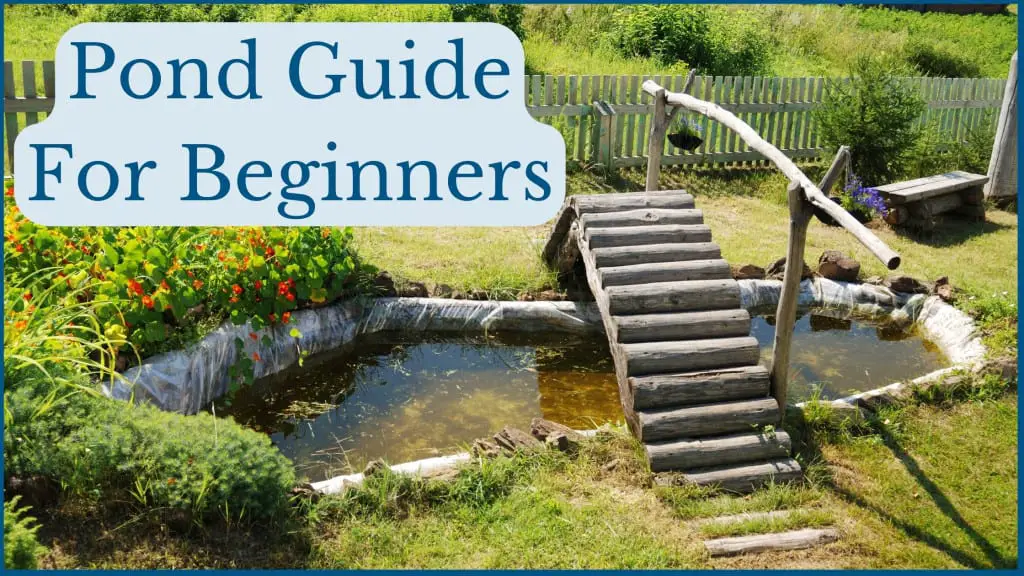So you are interested in creating your first pond? If you want to do it right the first time around, it is helpful to have a plan. You can formulate your plan by answering a series of questions. Follow the guidelines below, and let’s get started!
The basic questions for planning a pond.
Before you start digging a pond, here are the following essential questions for you to answer:
Guiding Questions:
We will explore these questions one by one in sufficient detail for you to set up a credible plan for your pond. It is quite a read, but we think you will have a better idea of how to go about when you are through. If you have any questions or comments, you are most welcome to send us a message.
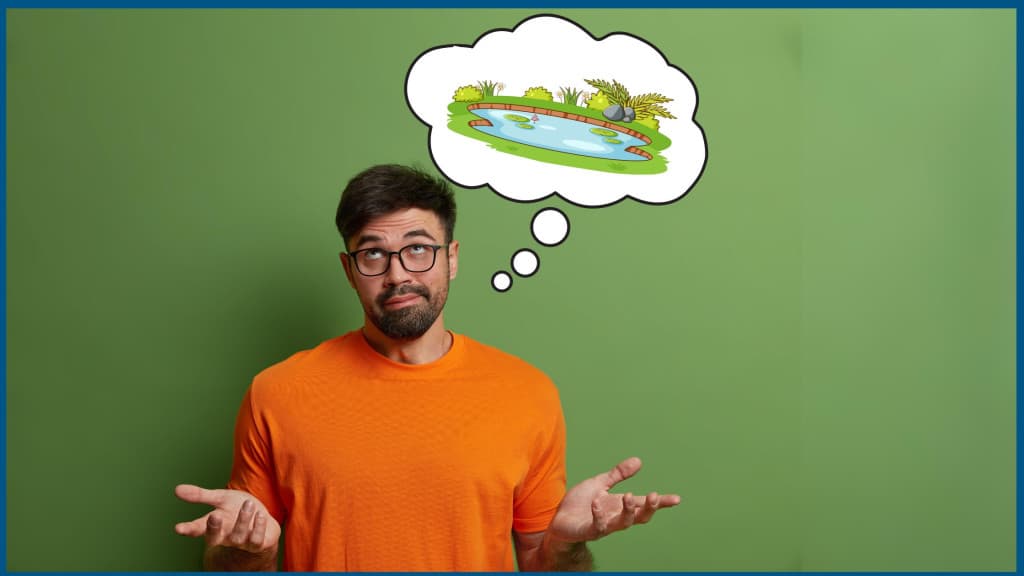
Why do you want a pond?
The first and foremost question is the purpose of the pond. We have listed some purposes below. There is a wide range of possible purposes ranging from pure aesthetics to production and water (quality) management around your home. More than one reason may apply but it is very well possible that you have one in mind that is not listed here.
- To beautify your garden and home
- To create a place of serenity and aesthetics for enjoyment, meditation, or religion
- To support and attract wildlife (large and small)
- To swim and recreate
- To keep local or exotic fish species, for instance, minnow or koi
- To produce fish for commercial purposes
- To create a stock for fishing
- To keep waterbirds like ducks, geese or swans, turtles, or other animals (crocodiles?)
- To treat wastewater
- To create a water storage reservoir
- To create a detention pond (temporary storage of stormwater)
- Any other purpose
Your answers are essential for the further planning of your pond.
What size, shape, and depth do you have in mind for your pond?
This question finds a partial response to your purpose for the pond. For instance, if you want to beautify your home, a small and shallow pond can do the trick, but if you want to swim and recreate, you need something bigger and deeper.
Then again, the size, shape, and depth of your pond will affect the water quality, circulation, and its aesthetics. Generally, larger and deeper ponds are ecologically more stable and, therefore, easier to maintain than smaller and shallower ones.
Most fish species require a maximum pond depth of at least 3 feet, but 5 or more does not hurt. Yet even 3 feet is a depth that already requires protective measures when small children have access. At least one side of the pool should have a gentle slope (or a device of some sort) that allows access in and out for amphibians and land animals that happen to fall in.
The shape of the pond should also allow for some circulation and avoid inert areas. Square or rectangular ponds are common for fish production, while oval or kidney-shaped ponds are better for circulation and a natural look.
Ultimately, the size of the pond will of course be limited by the size of your garden (ranging from a postage stamp plot in an urban backyard, to a property with significant acreage), which brings us to the next question to ponder.
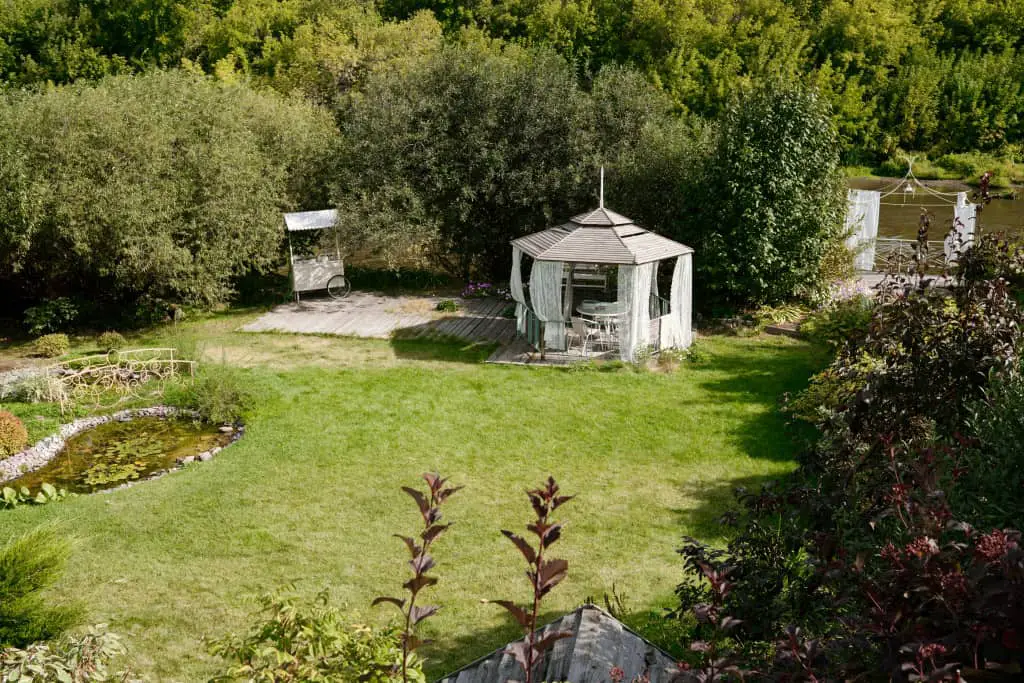
Where do you envision your pond to be located on your property?
The location of the pond is important because it determines the amount of sunlight, shade, wind, and surface water runoff that the pond will receive. Particularly when your aim is to beautify your home, you may already have a location in mind with high visibility from your home or when entering the property.
Ideally, the pond should be in a sunny spot, away from trees that drop leaves and debris into the water and buildings that could block the light. The terrain directly bordering the pond should be flat or have a stable slope to prevent erosion and sediment deposition in the pond.
The pond should further be sheltered from surface water runoff and overflow from housing, roads, drains, and channels during rainstorms. Unless your pond is small, it is good practice to plan an overflow, and it is very handy if you can siphon off excess water instead of pumping it out.
You better avoid any spot where windblown leaves and debris tend to collect, and you may consider a windbreak by planting low trees and shrubs around the planned pond area. Quite a lot to consider, but you will find the best location.
A crucial aspect is to exclude the presence of any underground utility line (gas, water, power, cables, sewer) before excavating the pond. In the USA you just call 811 and they will contact the utilities for you and a representative will visit you in a few business days to mark any existing (or planned) utility lines.
Even if you plan to power all accessories with solar, it is very practical to have a power outlet in the vicinity of the planned pond area. If there is none, it may be worthwhile to install one.
Finally, the location should be such that it is not exceedingly complicated to fill the pond with stored rainwater (or surface or tap water) and/or to (partially) drain the pond for purposes of water quality management.
Google Earth is a useful and free tool for site selection on large properties because it provides an excellent view of the site at any scale and it allows you to take reasonably accurate measurements, to sketch in the pond area, and to generate longitudinal profiles along any pathway to locate existing drainage patterns. (Google Earth download: https://earth.google.com/download).
REF FOR DETAILED LOCATION PLANNING HERE.
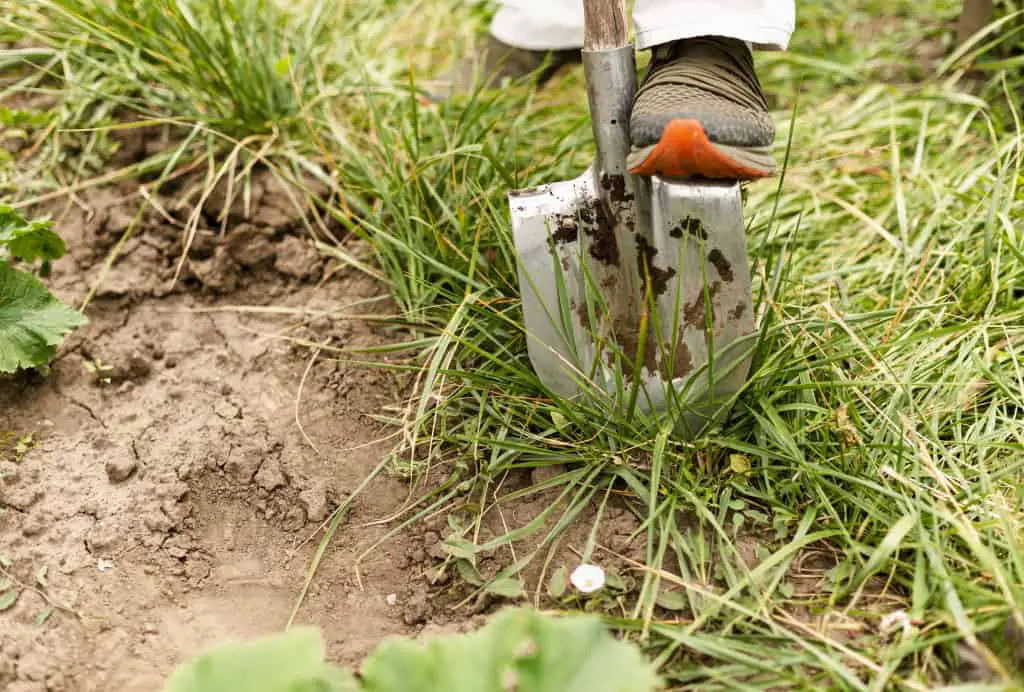
What construction method is feasible for your pond?
Now that you have a better grasp of the purpose, size, and location of the pond, the question of the pond construction material can be tackled. The most common methods of pond construction are a container, a preformed pond shell, or a pond liner which approximately corresponds with the size of the pond from small to large. These options are briefly presented below:
Container pond
Anything (old or new) that can hold water can serve as a container pond, and the ideas are endless: a pot, a glass jar, a wine barrel, plastic bowls, a washing basin, a bathtub, an old boat or canoe, a disused spa, etc. A further option is to create the container from masonry, stonework, or concrete (with some light reinforcement).
Even when a container is not entirely watertight, it can be improved by a sealant, and most leaks can be repaired with a suitable silicone. The container can be (partly) dug in or not, and it is, of course, possible to combine containers at different levels with overflow and waterfalls for a more dynamic setting. A tiny container pond is even suitable for a balcony, patio, or winter garden, but it can, of course, also be placed in the garden.
This is a cheap pond experience that can be great fun, enrich small wildlife, and provide amazing aesthetics. The main drawback is that it may be difficult to keep the pond cool during summer and free from ice during winter.
This is particularly the case if your container pond is relatively small and shallow and standing above ground. If winter involves prolonged and strong frost periods, few creatures may survive, and a solid ice layer may damage the container, particularly pottery.
The solution is to provide shade during the summer. In winter, the pond can be temporarily placed in a garage or garden shed if the container can be moved around. Other options for larger containers that cannot be moved around are to prevent the water from freezing over with a water heater or deicer. Particularly the heater is costly in operation.
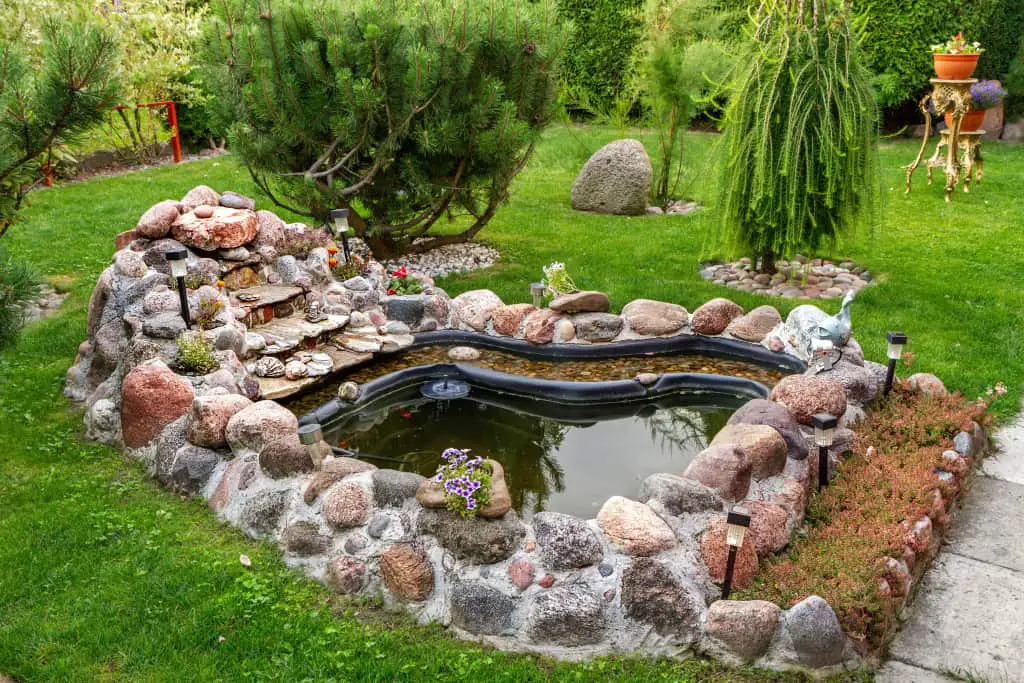
Preformed pond shell
The preformed pond shell is typically made of polyethylene or fiberglass reinforced polyester. They come in many shapes and sizes but tend to be shallow, usually limited to 2 or at most 3 feet with steep sides.
You can, of course, order a custom size, shape, and depth. Pond shells retail at under 100 dollars for a small basin (~100 gallons) up to several thousands of dollars for a larger basin of 2000 gallons or more.
Most pond shells come with shelves at different depth levels that provide for the installation of different types of aquatic plants. You can also create your own levels by hanging containers (plant pots) on the side of the pond. Make sure that your PE pond shell is UV resistant because it will eventually become brittle even when only slightly exposed to the sun or below the water table (UV radiation penetrates the water layer). Most pond shells are standard non-toxic to fish and plants, but it is useful to insist on this point before ordering.
Unless your pond shell is truly large, the installation of a pond shell is a doable project for one or two able hands that like to work out in the garden (instead of the gym).
REF FOR INSTALLATION HERE.
If needed, most resellers of pond shells will provide a contact with a qualified installer or organize this service for you for a cost. If your pond shell is of good quality, UV resistant, and correctly installed, it is a sturdy solution that will hold for many years.
Nevertheless, depending on your climate, the limited depth of the preformed pond shell may be an issue for most fish species as the water may become too warm or is bound to freeze over. It is generally more complicated to maintain a stable and healthy ecosystem in a small and shallow pond as compared with a deeper and larger pond. Also, even when many different shapes and sizes are available or can be ordered, the preformed pond shell may not be feasible for your intended use or aspired layout. For such situations, a freeform excavation with a pond liner is called for.

Pond liner
A pond liner is an impermeable geomembrane that prevents water from leaking away into the soil. Liners are made from flexible PVC (cheap), RPE (pliable and durable), Butyl rubber (durable), or EPDM rubber (ease of installation but underlay required) as large sheets with different thicknesses and reinforcements with composite layers. For smaller ponds, you may want to create rather vertical sides with shelves to provide sufficient depth for fish. This only works if the sides are stable (cohesive soil, this does not work for very sandy, or soft organic soils) and the liner sufficiently pliable.
For larger ponds it is recommended to create gentle and smooth slopes because it is difficult to arrange large liners in sharp inside corners (< 180°). If a stretch of liner in a sharp corner is not supported by soil, there is a high likelihood it will tear when the pond fills.
Pond liners are also available as preformed boxes or cylindrical tanks, which makes it somewhat like a pond shell with the difference that the material is flexible and not free standing. It requires a frame (brickwork, woodwork, etc.) when installed above ground level. The preformed liner needs to be secured with extension flaps onto the soil or, when a frame is used, with a termination bar fixed to the frame.
When ordering, you need to assure UV resistance and nontoxicity for aquatic lifeforms (NSF-61 certification applies to humans and animals). Further conditions for a durable operation are the allowable temperature range and oxidation and ozone resistance (disinfectants).
Comparing to the installation of a pond shell, the construction of a pond with a liner is slightly more complicated.
REF FOR INSTALLATION HERE.
The construction of a large pond requires earthmoving equipment and skilled operators (excavator, dump truck, compactor, etc.) as well as a little army of able hands to place the liner.
In conclusion, a quality liner that has been professionally installed can seal a pond for many years to come. The main advantage of pond liner is that you can create any size, form, and depth that you fancy for a moderate price (there are substantial price differences between materials though). The main drawback of the liner is that it remains relatively fragile. Dredging the pond is a risky exercise unless you have specialized equipment. Any access from cattle, large wildlife, rodents, swimmers, etc. constitutes a risk for a prolonged lifetime of the pond.
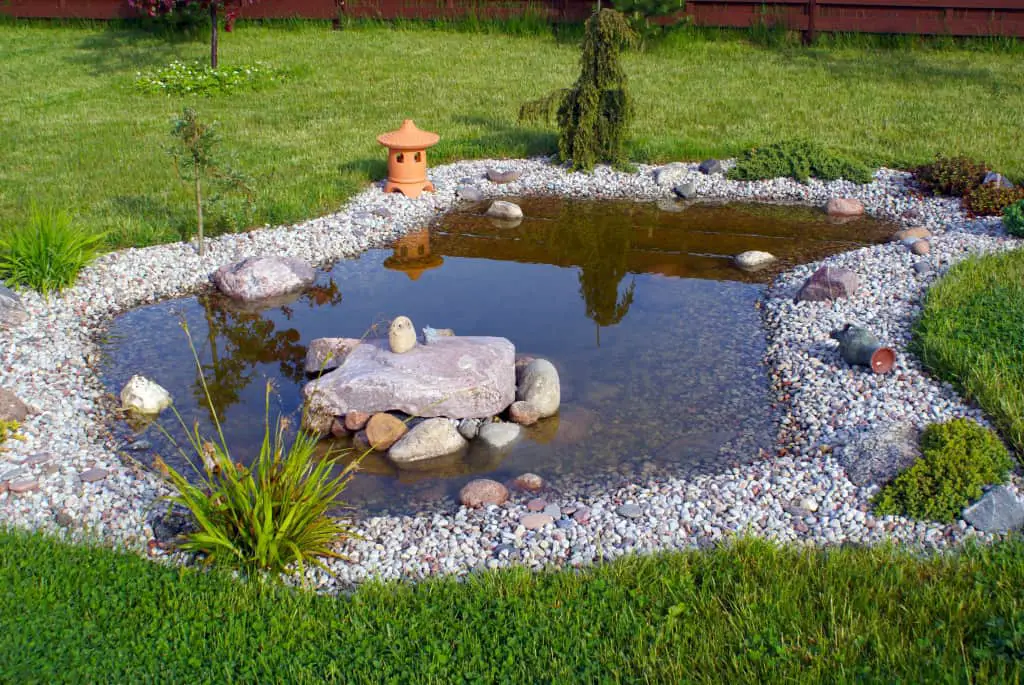
Alternatives to pond liner
If the subsoil is essentially impermeable (clay or clayey soil) at the intended pond location, or if you have a shallow groundwater level throughout the year, it may be possible to create a pond without any liner, just by excavating to the required depth. This is not common for the average garden in a residential area, but it is worthwhile to check if the option presents itself and complies with the intended purpose of your pond. Investigate if the clay continues to the required depth and test the impermeability first on a small scale.
For a natural groundwater pond, you may test the water quality for salinity, nutrient levels (N and P), and the concentration of potentially toxic substances to make sure that the quality of the groundwater is suitable for the intended use of the pond. A further point to investigate is the groundwater level fluctuation throughout the year (you would be disappointed to see your pond running dry during the summer months). It is highly likely that you require a permit for constructing a groundwater pond.
If these options are not available, you may consider a sealant. One of the better-known sealants is sodium bentonite which is a fully natural nontoxic clay. For a new pond, there are essentially two methods of application: the blanket method and the mixing method. With the blanket method, an extra depth of about 4 inches is excavated, a blanket of bentonite is (1 or 2 lbs./square foot) laid and covered with the 4 inches of excavated soil (from the extra depth). With the mixing method, the 4 inches of extra depth is mixed with the bentonite and then humidified and compacted before filling the pond. It takes time for the bentonite to swell and seal the pond effectively. We provide a detailed description of the pond construction with bentonite here.
(103_how to seal pond with bentonite).
When sealing a pond with bentonite, you can not make slopes steeper than 1/4 (V/H) at the most. This means that bentonite is not suitable for small ponds with a recommended depth for fish. When considering a construction depth of 4 foot (water depth will be less), the absolute minimum size is 32 by 32 foot. Just that you know before you start digging by hand.
In conclusion if you can create a pond without liner this is your cheapest option. A professionally installed sodium bentonite sealant is a good alternative for a somewhat larger pond. The fragility of the bentonite layer is an issue particularly with a waterfall (you must protect the impact location), for cleaning (you can cut plants, but you cannot pull out their roots), dredging is a no-go, and the hoofs of wildlife and cattle is likely to penetrate the bentonite layer.
A few words on concrete ponds
There is a saying that there are two types of concrete ponds, concrete ponds that are cracked and concrete ponds that will crack. Jokes aside, there is nothing wrong with concrete ponds, but as soon as you go deeper than 2 or 3 feet, and you deviate from a perfectly round form, there are substantial forces at play, particularly when groundwater and pond water levels fluctuate. Hence, lightly reinforced concrete can be used for small and shallow container ponds, but larger and deeper, square, or irregular shaped ponds, require detailed engineering assessments for soil properties, wall thickness and reinforcements. The investment for a larger concrete pond will always be substantial in comparison with other available options. If you have the necessary means, you can do it but take it seriously because it is not a standard DIY project.
We trust this digest of the main pond construction methods has helped you to get a better idea of the construction options that are suitable for the pond you are planning.
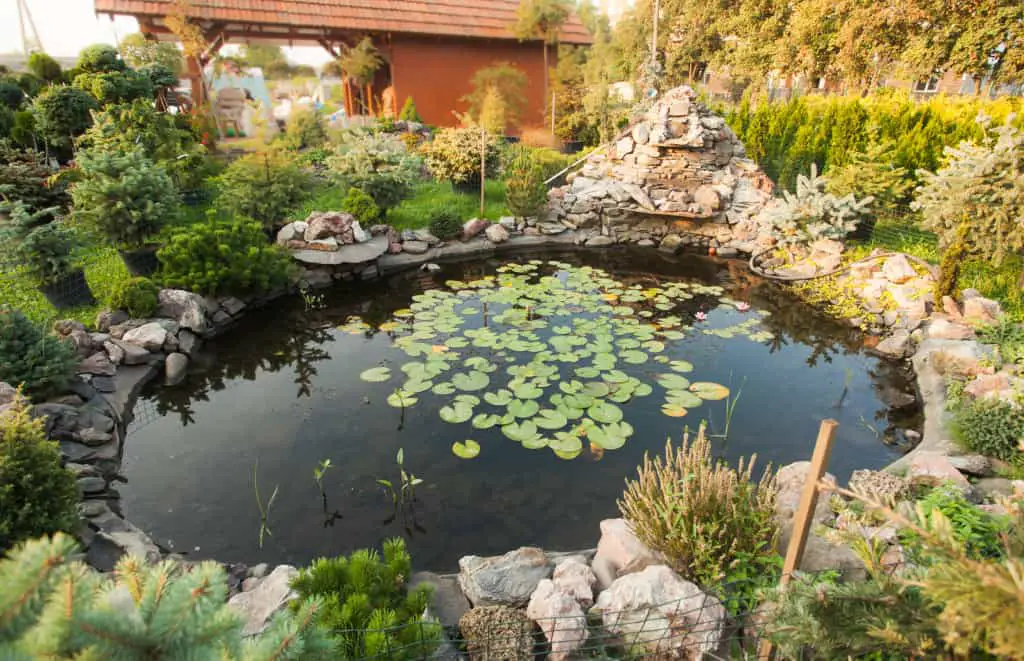
What accessories may be needed to manage your pond?
A pond is an artificial ecosystem, so if you wish to keep your pond clean, clear, and healthy, you need to support it to find a natural balance that provides such a clean, clear, and healthy environment. A surefire way to obtain such a healthy status in your pond is to keep your water cool, low in nutrients, high in oxygen and moving (something like the crystal-clear water of a creek in any mountainous area).
Unfortunately, the water in a pond without accessories, will not be moving. It will get hot during summer months the more so when it is a shallow pond. Its water may be high in nutrients (nitrogen and phosphate) from the start, but it will acquire excess nutrients when leaves accumulate in the pond, when you have lots of fish, when you overfeed the fish, and when you get algae blooms (the uncontrolled growth of algae). Finally, your water will be devoid of any oxygen because it is not moving, it has a high temperature, and there is a high nutrient load from fish, and decaying organic material from fish, plants, and algae (also called muck).
Apart from fish, plants, algae, and a range of waterborne creatures, bacteria are a crucial part of the ecosystem of any pond because they clean up dead organic material. These bacteria are of two types, aerobic (bacteria that use oxygen to clean up organic material), or anaerobic (bacteria that can clean up organic material without oxygen).
If there is oxygen available, the aerobic bacteria digest organic material and multiply at a high rate, reducing odors, maintaining clear water, and effectively cleaning a pond.
The anaerobic bacteria thrive in areas with low oxygen content and are much slower at digesting organic material. The anaerobic digestion process also releases hydrogen sulfide (smells like rotten eggs) and removes nitrates from the pond ecosystem through the release of nitrogen gas.
If the aerobic bacteria are predominant, your pond water will be clear, and the pond will over time, clear out nutrients (with support from anaerobic bacteria). If the anaerobic bacteria prevail, your pond water will be murky, and your pond will accumulate nutrients. You will be able to steer this process with the accessories that you install and operate which is fascinating and a substantial part of the joy of having a pond.
After this short introduction on pond water quality management, you find a brief review of the main accessories and their functions below. If you want to read more about water quality management, you may consult our article
(how to make pond water clear).
- Water pump. This is the heart of your pond water quality management system because it delivers water to filters, a fountain, and/or a waterfall. There is a huge variety of pumps with different capacities in terms of discharge and pressure. Further variations are for submersible, or external pump placement, and for mains or solar power supply. There are no precise recommendations on the pump capacity because much depends on the nutrient load (fish and netting) and oxygen supply from the pump itself and from an additional aerator. You may consider a capacity that allows to pump the full pond volume once per hour or once per two hours as guideline and your fountain or waterfall should adjust to the pump capacity and not the inverse.
- Skimmer. A skimmer skims water from the surface of the pond and retains any floating leaves and dirt on a grid for you to clean out regularly.
- Pond filters – mechanical. These filters pass the water through one or several filters (a variety of (synthetic) media in different densities) and retain impurities. These filters cannot filter out the smallest impurities that remain in suspension. You need to clean the filters regularly.
- Pond filters – biofilter. These filters provide a medium where aerobic bacteria settle to digest organic impurities that have not been retained in the mechanical filtration stage (skimmer, screener, filter). This filter presents an additional provision of the aerobic bacteria that are naturally available in the pond. It is always placed after the mechanical filtration stage.
- UV clarifier. It is a tube with an intense UV light inside. The purpose of an UV clarifier is to kill algae which it does effectively. The downside is that it also kills the bacteria that are naturally available and necessary in a healthy ecosystem. In our view this would be late on our list of priority accessories because there are many alternative options for a lesser cost.
- Chemical treatment of pond water. There are algaecides and bactericides for sale. This is for ponds that are out of kilter, and you proceed by a crude trimming of a part of the pond ecosystem. There are better ways to correct the situation.
- Biological treatment of pond water. This is a boost of bacteria and enzymes which is useful if you have a new pond, and you want to fast-track a stable ecosystem. If you use it for an established pond that is getting murky, it is not perse bad, but, in our view, it is not a sustainable solution. Nature adapts to the given environmental conditions by creating murky water if there is excess nutrients and lack of oxygen. If you do not like murky water, you change the environmental conditions by circulating the water, providing oxygen, and curtailing on nutrients. If you then want to improve the water quality faster, you may do the treatment once, but a monthly repeat just proves that the environmental conditions are not right.
- Pond water quality test kit. A test kit is essential when keeping fish. At a minimum you need to keep track of temperature (ideally at different depths), dissolved oxygen, pH and nutrient load (nitrate and phosphate), particularly the different stages of the nitrate cycle with the toxic ammonia and nitrite.
- Waterfall. Apart from the esthetic appeal, a waterfall does circulate and aerate the water, thus cooling the upper layers and increasing the dissolved oxygen concentration throughout. If your pond is deeper than 4 to 6 feet, the waterfall will be less effective for the lower water levels. It is worthwhile to consider the pump intake location and the waterfall at opposing sides of the pond to enhance the water circulation.
- Fountain. This is in outcome rather similar to the waterfall, esthetic appeal, circulation and oxygenation. With the same capacity, the circulation may be somewhat less effective than the waterfall.
- Surface aerator. This is similar to the fountain, but it aims to make more splash than height. They are less effective for deeper ponds and have a limited surface range but for a shallow pond it can work quite well.
- Air diffusor or bottom aerator. A bottom aerator emits tiny air bulbs at the bottom of the pond. The bulbs rise to the surface and create an upward flow with a downward flow all around it. This is less effective for shallow ponds but for ponds with a depth of 6 feet and more, this is truly the secret weapon of the pond owner because it provides circulation and oxygenation for moderate energy costs.
- Ultrasonic algae killer. This is typically implemented for ponds or lakes that are too large to effectively filter or even aerate. The ultrasound (inaudible to humans) is reportedly disturbing or damaging the vacuole of algae (a sort of floating device) which thereupon die. For a large pond, this may proof a useful and cost-effective method in combination with biological treatment (as there are few other options that work for a truly large pond or lake).
- Pond lights. Pond lights can add a dramatic effect to your pond at night. You can install underwater lights or lighting around the pond area to highlight the pond, the fish, or the water features. There is an enormous variety in colors and styles.
- Plants. Plants in and around the pond will improve its appeal markedly. Plants can contribute significantly to the water quality (oxygen, shade, nutrient uptake), provide protective space for fish and amphibians, and they attract and support a wide variety of insects. Plants around the pond retain leaves and dirt that would otherwise be blown into the pond. Plants in the pond grow at different depths and some are floating. There are also floating plant islands for sale, or you can craft your own. Do not plant large deciduous trees near the pond because they leave a mass of organic matter for you to clean out, nor plants with invasive root systems because they can destabilize or even penetrate your pond (bamboo).
- Fish. For some pond owners, fish are the very reason they want a garden pond while others may just be pleased with plants and natural aquatic insects and amphibians. Whatever the case, fish play an important role in the pond ecology. They use oxygen and produce waste so you should not overpopulate your pond with fish (rule of thumb: maximum of 1 inch of fish per square foot of pond area). For most fish species, it is recommended to provide some form of artificial oxygenation and filtration in addition to a varied plant population. Particularly in small shallow ponds, you should protect your fish from predators. Further risks are a leaking pond particularly when the subsoil is permeable, and the pond can empty overnight. When introducing fish to your pond, you should do so in small steps: introduce some fish in your pond when the vegetation has established itself. Do not overfeed your fish and avoid food that sinks immediately and adds to the nutrient load in the pond. If the pond ecology remains stable for several summer weeks, you can add some more fish.
- Deicer. A pond deicer is a floating electric device that heats sufficiently to keep a small opening in the ice. It is an essential accessory if your fishpond risks to freeze over. Most fish can survive low temperatures, but even in winter they need oxygen. If your pond freezes over, there is no oxygen exchange with the atmosphere and your fish risk to die, not from the cold, but from a lack of oxygen or the built-up of toxic substances from decaying waste at the bottom of the pond. It is recommended to operate the deicer with an aerator because these devices help each other out and they work fine in frosty conditions.
- Water heater. The water heater is similar to the deicer, but it is intended to prevent the entire pond from freezing over. Its operation requires much more energy than the deicer without additional benefits. Unless you have a specific reason to do so, do not use a water heater but use a deicer with an aerator when winterly conditions prevail.
- Pond manual tools: rake, reed cutter, net, skimmer, etc. These are dedicated tools often with a telescopic pole that allow to cut and trim water plants and to remove floating plants and debris from the pond. Unless your pond is a tiny container pond, this is essential equipment. If your have a pond liner, you better avoid using a rake or any sharp hand tools.
- Pond vacuum (also called pond vac). A pond vacuum consists of a pump that sucks up water with debris deposited at the bottom of the pond into a container where it is cleaned through a net and filters and released without most of the debris, either in the pond or elsewhere (the water is rich in nutrients and good for gardening). If you have many fish with limited aeration, the excess nutrients will deposit at the bottom of the pond, and it is likely that you must vacuum regularly to avoid algae bloom and a critical water quality. It may be somewhat risky to use a pond vacuum in a liner pond or a bentonite pond but with careful handling it is very well possible.
- Pond cover – netting: Netting with different mesh sizes and different materials: suspended or floating to protect your fish from cats, raccoons and birds like heron, cormorant, crane etc. It also protects from leaves and debris blown in, so it reduces the nutrient load.
- Pond cover – closed: provides full protection against cats and herons, it keeps out leaves and dirt, and it shields the pond from freezing over (unless there are extremely low temperatures for a prolonged period. It makes a lot of sense in winter, but in summer, it defies the very purpose of a pond.
- A fence. This may be last but is surely not least as it is essential for keeping your kids safe. It may also be required for keeping animals in or out of the pond area. If a fence is needed for your pond, you may consider including other domains of your garden for instance a vegetable garden (unless you have ducks in your pond). The fenced area may also be completed with an alarm system.
We trust this digest of the main pond accessories and gadgets has helped you to get a better idea of what is needed for the pond you are planning. Your selection of accessories may even lead you to reconsider some of your reasonings on pond location, size, and construction method.
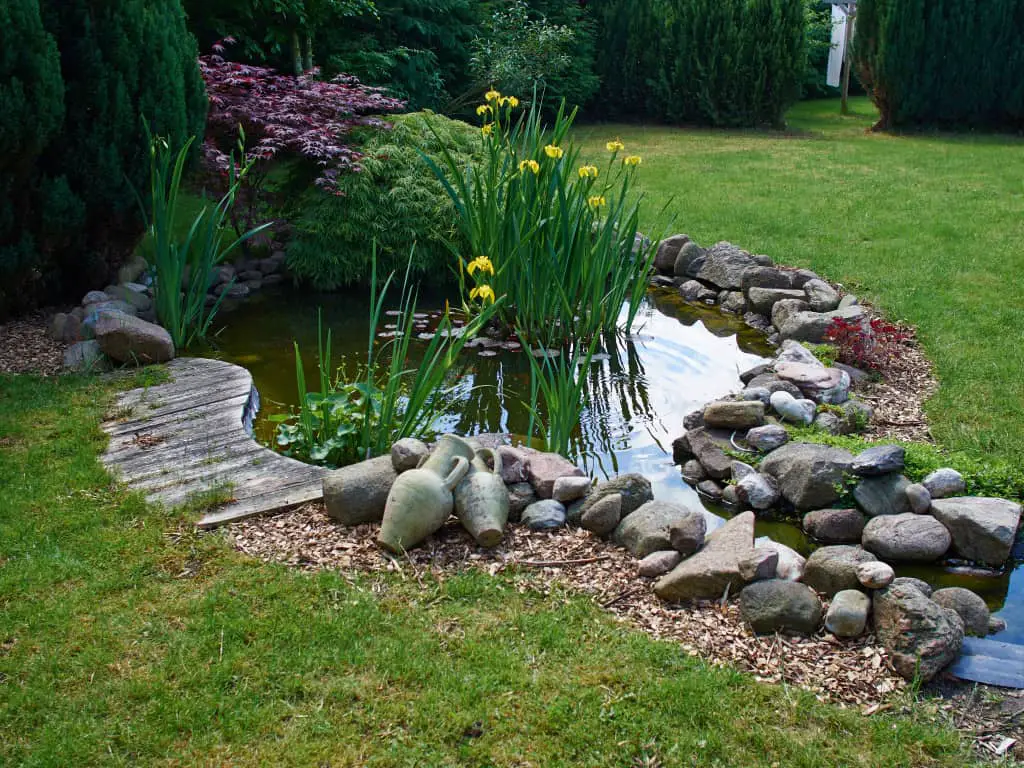
Are you ready for some extra maintenance in your garden?
Unless you are lucky enough to have a natural pond on your property (in and outflow regulated by groundwater and/or surface water), you have an artificial pond with an artificial ecosystem that requires maintenance to keep a healthy and sound environment.
Maintaining the water level
The first thing to maintain is the water level, which needs to be constant, give or take a few inches (unless you have a very shallow pond, and you need an almost stationary water level). If you are sure there is no leakage, you just fill up the pond as needed every few days. It is preferred to use rainwater because it has no chlorine and is low in nutrients and minerals (soft water). If you use tap water, it is recommended to let it stand for a day in an open container in the sun for any chlorine to disappear.
If you wonder whether your pond is leaking, you need to keep track of the gains (rainfall and added water) and losses (evaporation and leakage) for several days to estimate if and how much the basin is leaking. If you have a container pond standing above ground, you may just see the leakage in which case you just proceed to repair the container.
If your pond is too full after excessive rain or a filling mishap, you may need to reduce the water level with a bucket or a pump for larger ponds.
Maintaining the water quality
A critical task is the testing of the water quality. The acceptable water quality depends on the purpose of the pond. For fish, you need to keep a close eye on water temperature (cool in summer, not frozen in winter), dissolved oxygen content (high), pH (around neutral), phosphate (low), and nitrate, particularly the toxic ammonia and nitrite (low). Different fish species can withstand different conditions, but these are the general tendencies. There are dedicated test kits available.
Water quality – algae
One of the most prominent water quality problems in ponds is algae. Algae are photosynthetic organisms that range from single cellular species to large plant-like structures (they are not plants, though). Algae are an essential part of a healthy aquatic ecosystem. The growth of algae is defined by the availability of nutrients, temperature, and light.
If there is excess nutrient availability (particularly nitrate and phosphate), the growth of algae may spiral out of control during the summer months (warm temperatures and lots of light). The algae will use up all the oxygen in the pond water, which will cause plants, fish, and algae to suffer and die, which will increase the amount of nutrients in your pond, and so on. This process is known as an algae bloom that may, along the way, increase the pH of your pond water and derail the nitrate cycle to increase the level of toxic ammonia for your fish that already suffer from a severe lack of oxygen.
The ideal way to prevent such a disaster is to limit the availability of nutrients in your pond ecosystem, which can be done by some (or all) of the following measures:
- preventing the inflow of nutrient-rich surface water runoff or groundwater,
- preventing leaves and other organic matter from falling in the pond
- limiting the number of fish (or waterfowl) and keeping track of the amount of feed you supply them,
- operating a biofilter,
- aerating the pond with extra oxygen by means of a surface or bottom aerator (diffusor), a fountain, or a waterfall.
- reducing the algae with fish that feed on algae or a UV clarifier
- vacuuming the muck (or nutrient store) collected at the bottom of the pool
A low nutrient level will be attained gradually by a rational selection of the above measures and will establish a balanced and healthy ecosystem in your pond.
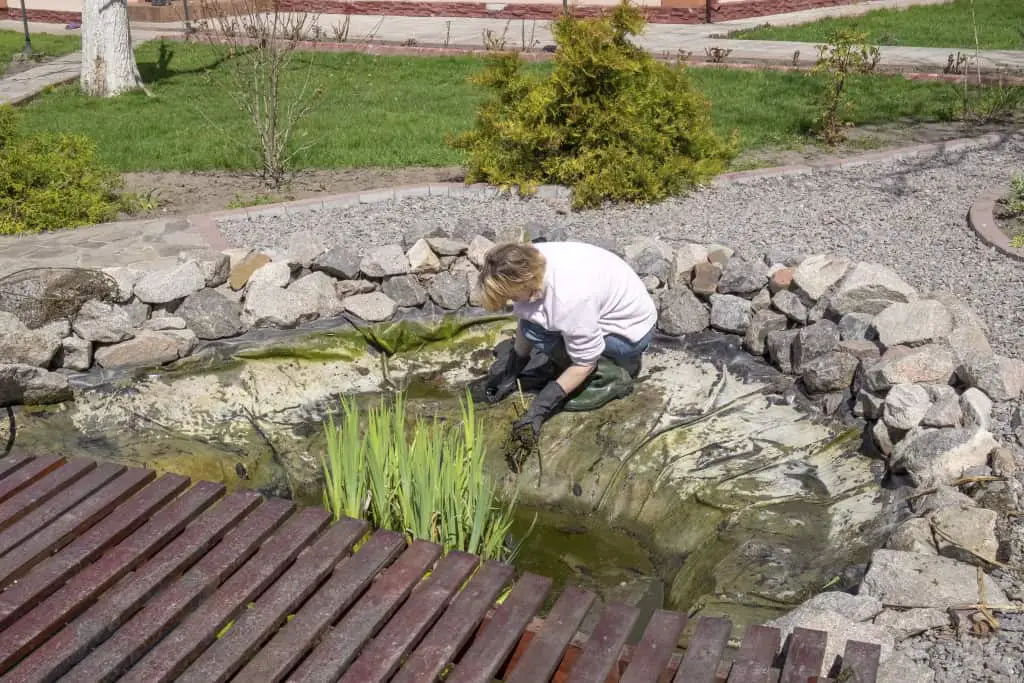
Other maintenance tasks
Apart from the water level and the water quality, you should take care of the tools and accessories that are operated in and around the pond. This will include all maintenance tasks as per the manual for the pump and several types of filters, skimmer, pond vacuum, aerator, fountain, deicer, etc. Further items that may be part of your pond and require your attention are a fence, netting to protect fish from predators, and accessories to beautify the pond, like fountains, lighting, floating plant island, and the like.
Occasionally you should trim the plants in and around the pond that grow too large or that cover too much of the surface area. You may also verify if the pond remains level if the overflow is working properly, and if there is no inflow from uncontrolled surface water with dirt.
The frequency and intensity of the pond maintenance will vary depending on the season, the weather, and the condition of the pond. It is key that you enjoy the maintenance of the pool as much as you enjoy the pool itself and that you take pride in the presentation and conservation of a healthy ecosystem.

What is the necessary budget for constructing and operating a pond?
It may be clear from the preceding text that it is not possible to give specific prices for ponds. What we will try to do is to present some possible price ranges for the construction and operation of the different pond types. Prices will, of course, differ per region and country/continent, but you may get an idea of the costs before you start.
We start with the container pond. The low-cost option assumes you have an existing container of, say, 100 to 300 gallons that you revamp and decorate with stones, gravel, and plants from your garden. You just purchase a small 25-watt pump set with filter and fountain (~$65), some water plants, and a couple of goldfish, and you are all set for about $100. The monthly energy use will be around 13 kWh if you let it run 24/7.
The other side of the container pond spectrum is a 10 000-gallons concrete container pond, designed and custom made for your residence with a wide waterfall, (laminar) fountains, generous decoration, and all amenities like filtration, lighting, and pavement. Such luxury will set you back at least 50 000 dollar and likely a lot more. With a 24/7 operation the monthly energy use may be around 500 kWh or more.
The next category is the pond shell. The cost for a good quality PE 100-gallon preformed shell is around $200 (UV-stabilized, chipping, fading, or cracking resistant, and nontoxic for fish and plants). The pump-filter-fountain combination for the low-cost container pond is appropriate ($65). If you go fancy on decoration (stones, gravel, plants, and some fish), you may double that investment to something like $500. Monthly energy use is an indicative 13 kWh.
Larger pond shells up to 2000 gallons or more are purchased for several thousand dollars just for the shell without transport. With transport, excavation, installation, decoration, accessories, etc., the investment costs may easily exceed 10,000 dollars. For ponds even larger than 2000 gallons, transport becomes a dealbreaker to the extent that you are better off with a flexible liner.
The table below gives the approximate cost for pond construction with different materials in dollars per square foot. This table presents a lower price indication and should be used for the purpose of comparison between pond materials. The listed price may be on the lower side, for small ponds you should expect a higher price per square foot. For a precise cost estimate, you should request one or several price quotations for your project and requirements (size and shape, UV, NSF-61, etc.).
Table 1: Indicative (~) price in US dollars per square foot for different pond construction materials.
| Product/construction material | Indicative bulk price in $/ft² | Comments |
| Reinforced concrete | ~20 | On average 10” floor and sidewalls, foundation, reinforcement, casing, joints, etc. |
| Cement lining | ~5 | 5” cement with wire reinforcement |
| PE preformed pond shell | ~5 | For structural reasons, large shells tend to be more expensive per square foot. |
| Fiberglass reinforced preformed pond shell | ~5 | For structural reasons, large shells tend to be more expensive per square foot. |
| PVC liner | ~0.20 | Without UV protection, underlay required, not ideal for cold climates, can be toxic |
| RPE regular | ~0.80 | Pliable and durable |
| Butyl rubber | ~0.80 | Least pliable but exceptionally durable |
| EPDM rubber | ~0.60 | Underlay required, susceptible to tearing, reasonably flexible |
| Underlay | ~0.15 | Geotextile, essential to protect some liners |
| Sodium bentonite | ~0.35 | Estimate based on 3 lbs./square foot (loam/silt soil) |
| Sodium bentonite | ~0.47 | Estimate based on 4 lbs./square foot (sandy loam soil) |
| Sodium bentonite | ~0.95 | Based on 8 lbs./square foot (coarse sand soil) |
Although liners and bentonite are cheaper, you should study if these materials are appropriate for the size and form of your pond and for its intended use.
In conclusion, it is very well possible to enjoy a pond with a balanced ecosystem for a moderate initial outlay and minor energy costs.
If the budget is not a major concern, you can spoil yourself being the architect of a striking water feature for you to enjoy.
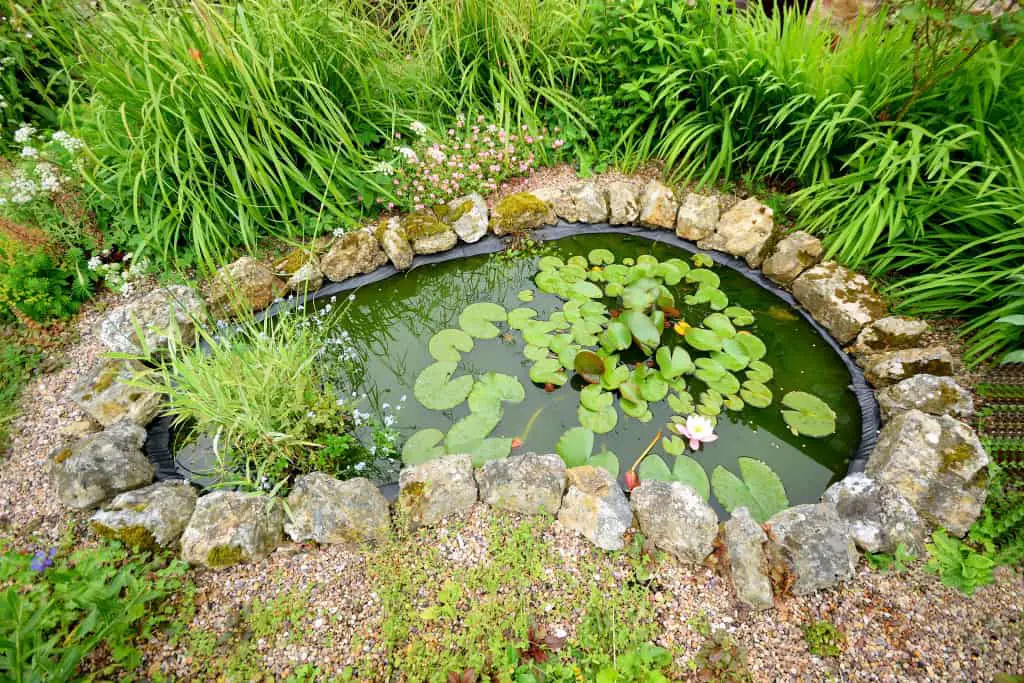
Verify beforehand if you require any authorization for your pond
Before you embark on a pond project it is highly recommended to verify if authorization from any authority is required. This holds particularly for larger projects and if you plan to excavate below groundwater level. You should also inquire if it is allowed to drain excess pond water on the municipal sewer system.
The relevant authorities will likely be your municipality, and/or a water management authority and municipal wastewater treatment service provider. If you rent your home, you should contact your landlord, and if you happen to partake in a collective garden or a garden community, you may communicate with the community or their representatives before you start your project.
